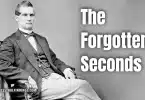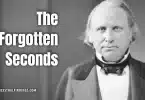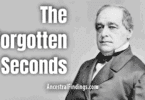As we continue “The Forgotten Seconds” series — exploring the lives of U.S. vice presidents who never became president — we arrive at a man whose political career spanned decades and whose life ended just as he reached one of the highest peaks of national office. Thomas Andrews Hendricks, vice president under Grover Cleveland, served only a few short months before his sudden death in 1885. Yet his legacy endures, especially in the state of Indiana, where he left a lasting mark on politics and public memory.
Deep Roots in Early America: The Hendricks Family Line
Thomas A. Hendricks was born on September 7, 1819, in Muskingum County, Ohio. His family came from a proud line of early American settlers. His paternal grandfather, Thomas Hendricks Sr., had fought in the American Revolution and settled in western Pennsylvania before eventually moving to Ohio. The Hendricks line itself was of Dutch and English descent, having arrived in the American colonies in the early 1700s, possibly earlier, with early generations residing in Virginia and the Mid-Atlantic.
His father, John Hendricks, was a farmer and devout Presbyterian who moved the family westward when Thomas was a young boy. Around 1820, the Hendricks family settled in Shelby County, Indiana, as part of a broader westward migration of families looking for fertile land and opportunity. Indiana, at that time, was still considered the edge of the American frontier. The state had only joined the Union in 1816, just a few years before the Hendricks family arrived.
Thomas’s mother, Jane Thomson Hendricks, also came from Scots-Irish and English ancestry. Her family was Presbyterian and of early American settlers, with roots tracing back to Pennsylvania and New Jersey. This religious and cultural background shaped Thomas’s values: a belief in order, education, public service, and moral discipline.
He grew up in Indiana during its formative years, watching the state transform from frontier land into a settled and politically active part of the country. These early influences helped shape his belief that government had a responsibility to work for the benefit of the common man.
Education and Early Law Career
Thomas was a bright and serious student. His parents, despite being farmers, emphasized education, and he took full advantage of the opportunities available to him. He attended Hanover College in southern Indiana, graduating in 1841. Hanover was one of the oldest private colleges in the state and had a strong Presbyterian affiliation, reflecting the values of his upbringing.
After college, Hendricks studied law in Chambersburg, Pennsylvania, under the guidance of relatives, and then continued his legal training in Shelbyville, Indiana. He was admitted to the Indiana bar in 1843 and began practicing law in Shelbyville. His sharp mind, calm demeanor, and persuasive courtroom presence made him successful from the start.
Marriage and Personal Life
In 1845, at the age of 26, Thomas Hendricks married Eliza Carol Morgan, a refined and well-educated woman from a respected local family. Eliza was the daughter of Dr. Isaac Morgan, a prominent physician in Shelbyville, and Sarah Porter Morgan, who came from a family of early Kentucky settlers. The Morgans were known for their community involvement and hospitality, and Eliza was raised in a home that emphasized good manners, intellect, and civic responsibility — values she would carry throughout her life.
Eliza was known for her quiet strength, gracious personality, and unwavering support of her husband’s public career. She often hosted political gatherings and social events at their home, particularly during Thomas’s tenure as governor of Indiana. Though she avoided the spotlight, those who knew her said she was intelligent, well-read, and deeply devoted to her husband. She also took a keen interest in charity work and church activities.
The couple had one child, a son named Morgan Hendricks, who tragically died in infancy. They had no surviving children. The loss of their only child was a quiet sorrow they carried for the rest of their lives, though neither spoke of it often in public.
Despite the demands of politics, Thomas and Eliza remained close throughout their 40-year marriage. Their letters, though few survive, suggest a deep mutual respect and companionship. Eliza accompanied her husband on many of his political travels and remained at his side through every stage of his career — from congressman to senator, governor, and eventually vice president. When Thomas passed away in 1885, Eliza was overcome with grief and withdrew from public life, living quietly until her own death in 1903 at the age of 81. She was buried beside her husband at Crown Hill Cemetery in Indianapolis.
Their marriage was often described as a true partnership, marked by dignity, affection, and endurance through both triumph and tragedy.
Rising Political Career
Hendricks’s entry into politics came early. A loyal member of the Democratic Party, he was elected to the Indiana General Assembly in 1848. His political rise was steady. In 1851, he was elected to the U.S. House of Representatives, where he served two terms during the turbulent decade leading up to the Civil War.
While in Congress, Hendricks opposed some of the more radical measures being proposed regarding slavery, preferring compromise to confrontation. However, he was not considered a “doughface” — a Northern Democrat who supported the Southern slaveholding cause — and he maintained a delicate balance between unionism and states’ rights.
In 1855, President Franklin Pierce appointed him as Commissioner of the General Land Office, a post he held for two years. This experience with federal land policies was crucial in a time of expansion, settlement, and railroad building.
In 1860, Hendricks ran for governor of Indiana but lost narrowly. However, in 1863, during the Civil War, he was elected to the U.S. Senate, where he served until 1869. In the Senate, Hendricks opposed many of the Reconstruction policies favored by the Republican majority. He believed they were too harsh and counterproductive to national unity. Though not sympathetic to the Confederacy, he strongly supported states’ rights and a more conciliatory postwar policy.
He ran for Governor of Indiana again in 1872 and won. He served one full term from 1873 to 1877. His time as governor was marked by a firm but fair approach to state finances, education, and support for public works. He gained a reputation as a calm, thoughtful administrator and was one of the most respected Democrats in the Midwest.
Presidential Ambitions and the 1876 Election
Hendricks was widely considered a potential presidential candidate in the 1870s. In 1876, he was nominated as the Democratic candidate for Vice President on the ticket with Samuel J. Tilden. The Tilden–Hendricks ticket won the popular vote, but the election became mired in dispute over electoral votes in several Southern states. Ultimately, the controversial Compromise of 1877 awarded the presidency to Republican Rutherford B. Hayes. Hendricks, along with Tilden, faded into political frustration — though he never completely gave up the idea of serving again.
He spent the next several years practicing law, advising the Democratic Party, and continuing to be seen as one of the party’s elder statesmen.
Vice Presidency Under Grover Cleveland
In 1884, the Democrats returned to national power with the election of Grover Cleveland, the reform-minded governor of New York. As a gesture to party unity and to balance the ticket geographically and ideologically, Cleveland selected Thomas Hendricks — a Westerner, a traditional Democrat, and a respected senior figure — as his running mate.
They won the election, and Hendricks was sworn in as Vice President of the United States on March 4, 1885. Sadly, Hendricks never had the chance to make a significant impact in this role.
Already in poor health at the time of his inauguration, Hendricks found it difficult to keep up with the physical and mental demands of office. He died just eight months later, on November 25, 1885, at his home in Indianapolis. He was 66 years old. His death left the office of vice president vacant for the rest of Cleveland’s first term, since there was no provision for replacing a vice president until the 25th Amendment was passed decades later.
A Lasting Indiana Legacy
Hendricks’s funeral in Indianapolis was attended by thousands. His casket was viewed by the public in the Indiana State Capitol, and he was buried in Crown Hill Cemetery, the resting place of many prominent Hoosiers.
The Soldiers and Sailors Monument in downtown Indianapolis features a statue of Hendricks, and his name lives on through streets, schools, and counties across the Midwest. The Hendricks Monument, just outside the Indiana Statehouse, remains one of the oldest statues of a vice president in the country.
Pros and Cons of His Vice Presidency
Pros:
- Hendricks had decades of experience in state and federal politics.
- He was respected for his integrity and ability to unite differing factions within the Democratic Party.
- His selection balanced the 1884 ticket geographically and ideologically, helping Cleveland win the presidency.
- He was popular in Indiana and the broader Midwest, serving as a bridge between older Democratic ideals and modern reformers.
Cons:
- Hendricks was already in poor health when elected, which limited his ability to serve.
- His vice presidency lasted only eight months, giving him no real opportunity to influence national policy.
- His traditional views were sometimes out of step with the Democratic reformers of the late 19th century.
- His brief time in office meant he left little personal legacy at the national level.
Conclusion
Thomas A. Hendricks is remembered today as a dedicated public servant with deep Indiana roots and a long-standing commitment to Democratic ideals. Though his time as vice president was tragically short, his broader career reflected the complexity and evolution of American politics from the antebellum era through Reconstruction and into the Gilded Age. He may have been denied the chance to leave his mark on the executive branch, but in Indiana — and among historians of the vice presidency — his name is far from forgotten.






